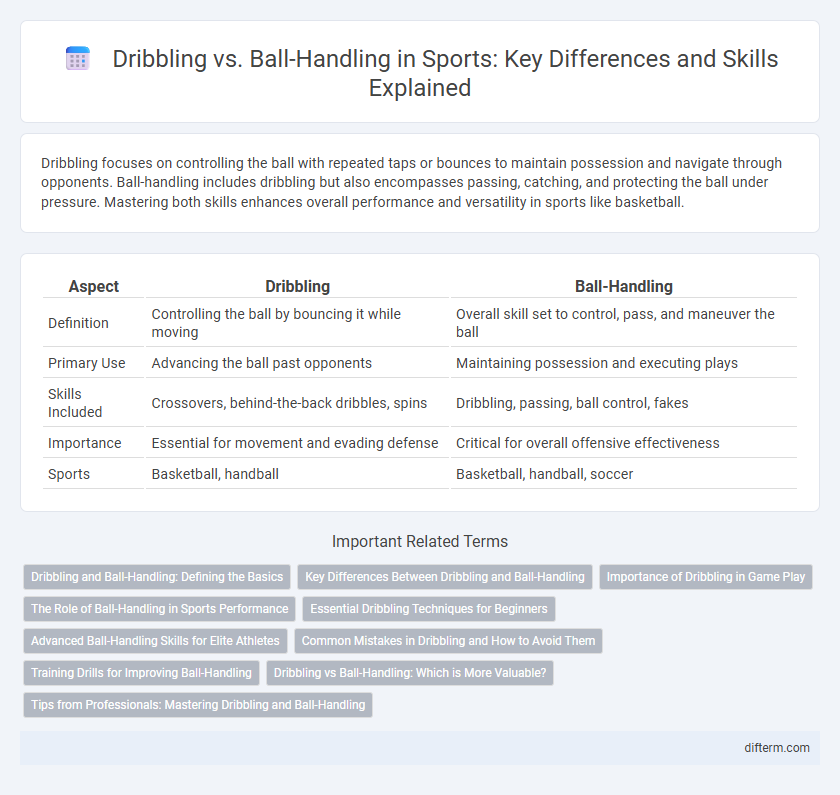Dribbling focuses on controlling the ball with repeated taps or bounces to maintain possession and navigate through opponents. Ball-handling includes dribbling but also encompasses passing, catching, and protecting the ball under pressure. Mastering both skills enhances overall performance and versatility in sports like basketball.
Table of Comparison
| Aspect | Dribbling | Ball-Handling |
|---|---|---|
| Definition | Controlling the ball by bouncing it while moving | Overall skill set to control, pass, and maneuver the ball |
| Primary Use | Advancing the ball past opponents | Maintaining possession and executing plays |
| Skills Included | Crossovers, behind-the-back dribbles, spins | Dribbling, passing, ball control, fakes |
| Importance | Essential for movement and evading defense | Critical for overall offensive effectiveness |
| Sports | Basketball, handball | Basketball, handball, soccer |
Dribbling and Ball-Handling: Defining the Basics
Dribbling involves continuously bouncing the ball on the court using one hand to maintain control while moving, which is essential for advancing play in basketball. Ball-handling encompasses a broader skill set, including dribbling, passing, catching, and protecting the ball from defenders to effectively manage offensive strategies. Mastery of dribbling improves agility and speed, while comprehensive ball-handling skills enhance overall game performance and decision-making.
Key Differences Between Dribbling and Ball-Handling
Dribbling involves continuously bouncing the basketball with one hand while moving to maintain control and advance the play, primarily emphasizing timing and hand-eye coordination. Ball-handling encompasses a broader range of skills including dribbling, passing, catching, and maneuvering the ball under defensive pressure to create scoring opportunities and maintain possession. Mastery of ball-handling enhances a player's ability to execute complex moves and decisions, whereas dribbling is a fundamental component within that skill set focused on ball control during movement.
Importance of Dribbling in Game Play
Dribbling is a fundamental skill in basketball that allows players to maintain control of the ball while advancing on the court, creating opportunities for passes, shots, and strategic positioning. Mastering dribbling techniques improves a player's agility, coordination, and ability to evade defenders, directly impacting offensive effectiveness. While ball-handling encompasses a broader range of skills, dribbling remains critical for maintaining possession and executing dynamic plays during game situations.
The Role of Ball-Handling in Sports Performance
Ball-handling skills form the foundation for effective dribbling, influencing an athlete's ability to control and maneuver the ball under pressure during competitive play. Enhanced ball-handling improves reaction time, precision, and coordination, directly impacting overall sports performance in basketball, soccer, and other ball-centric disciplines. Mastery of ball-handling techniques contributes to strategic advantages, enabling athletes to execute complex plays and maintain possession against aggressive defense.
Essential Dribbling Techniques for Beginners
Essential dribbling techniques for beginners focus on controlling the basketball with fingertips, maintaining low body posture, and keeping eyes up to enhance court awareness. Proper ball-handling emphasizes consistent practice of crossover, behind-the-back, and between-the-legs dribbles to develop hand speed and coordination. Mastering these skills improves offensive movement, reduces turnovers, and increases scoring opportunities in game situations.
Advanced Ball-Handling Skills for Elite Athletes
Elite athletes develop advanced ball-handling skills that encompass more than basic dribbling, including precise control, rapid directional changes, and deceptive maneuvers to maintain possession under pressure. Superior ball-handling integrates hand-eye coordination, finger strength, and spatial awareness, enabling players to execute complex moves like crossovers, behind-the-back dribbles, and spin moves with fluidity. These refined techniques differentiate elite performers by enhancing offensive versatility and increasing the ability to break defensive traps during high-stakes competition.
Common Mistakes in Dribbling and How to Avoid Them
Common mistakes in dribbling include looking down at the ball, using only the fingertips instead of the pads of the fingers, and dribbling too high, which reduces control and speed. To avoid these errors, players should maintain head up vision, practice finger-tip control drills, and keep the ball low--around waist level--to enhance maneuverability. Consistent practice of proper techniques can significantly improve ball-handling skills and overall on-court performance.
Training Drills for Improving Ball-Handling
Training drills for improving ball-handling focus on enhancing control, coordination, and agility with the basketball. Effective exercises include stationary ball control drills such as finger taps and fingertip dribbles, as well as dynamic drills like zigzag dribbling and two-ball dribbling to simulate game-like scenarios. Incorporating cone drills and resistance training further develops hand speed and dribbling accuracy, essential for effective ball-handling in competitive sports.
Dribbling vs Ball-Handling: Which is More Valuable?
Dribbling and ball-handling are both essential basketball skills, but ball-handling encompasses a broader range of techniques including dribbling, passing, and controlling the ball under pressure. Effective ball-handling improves overall gameplay by enabling players to maintain possession, create scoring opportunities, and execute plays efficiently. Mastery of ball-handling typically holds more value as it directly influences a player's ability to navigate defenses and contribute to team success.
Tips from Professionals: Mastering Dribbling and Ball-Handling
Mastering dribbling and ball-handling requires consistent practice, with professionals emphasizing the importance of maintaining low body posture and keeping the eyes up to anticipate defenders. Effective drills include stationary ball control exercises, crossover moves, and varying speed to simulate game situations. Incorporating hand-eye coordination training and ambidextrous dribbling enhances fluidity and control, essential for professional-level performance.
dribbling vs ball-handling Infographic

 difterm.com
difterm.com